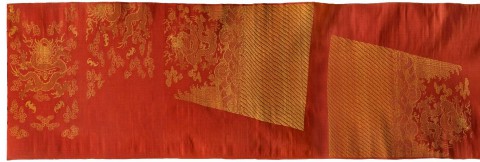Length of fabric for a kimono
karta katalogowa kolekcji
Rzemiosło artystyczne
Far East
19th century
Silk
630 x 77 cm
Wil.2793
A narrow piece of fabric with the motif of a dragon amidst clouds. According to Japanese tradition, kimonos were made only upon concrete individual requests out of woven and decorated strips of fabric some 9 metres long and about 50 cm wide. The cut of a kimono is very simple, always identical and the outcome of sewing together rectangular fragments of fabric of assorted sizes. Only the length of the sleeves varies – they are long and richly decorated for unmarried women, while the sleeves of kimonos belonging to married women are narrow and fit snugly. Apart from the kimono, all elements of the Japanese woman’s costume are invariable and traditional – from the undergarments to the shoes, coat and hairdo. In modern-day Japan women wear kimonos for assorted holidays, celebrations and ceremonies.
The colours and patterns of the kimono fabric are extremely eye-catching and decorative; they are to match the taste and likings of the owner and can be adapted to a special occasion or time of the year.
Anna Ekielska-Mardal
Polecane

Nanban-type table
Nanban, or the “art of the southern barbarians”, denotes sixteenth- and seventeenth-century Japanese works of decorative art, reflecting a discernible …

Two oil lamps
The lamps were made in Europe out of damaged small teapots. Oil lamps had been used in Europe since antiquity, …

The Baroque concept of theatrum mundi in the former Commonwealth
The topos of theatrum mundi has appeared in culture and literature since antiquity. The conviction that the world is a …

















